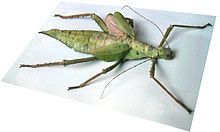| Euphasmatodea Temporal range: Aptian–Recent PreꞒ Ꞓ O S D C P T J K Pg N | |
|---|---|

| |
| Heteropteryx dilatata from Malaysia | |
| Scientific classification | |
| Domain: | Eukaryota |
| Kingdom: | Animalia |
| Phylum: | Arthropoda |
| Class: | Insecta |
| Subclass: | Pterygota |
| Infraclass: | Neoptera |
| Cohort: | Polyneoptera |
| Order: | Phasmatodea |
| Suborder: | Euphasmatodea Bradler, 1999 |
| Superfamilies | |
|
Aschiphasmatoidea | |
| Synonyms | |
|
Verophasmatodea Zompro, 2004 | |
The Euphasmatodea, also known by its junior synonym Verophasmatodea is a suborder of the Phasmatodea, which contains the vast majority of the extant species of stick and leaf insects, excluding the Timematodea. The oldest record of Euphasmatodea is Araripephasma from the Crato Formation of Brazil, dating to the Aptian stage of the Early Cretaceous.
Superfamilies and families
The suborder Euphasmatodea was previously divided into two infraorders: the Areolatae and Anareolatae, based on the presence or absence of an "areola": a small ring of colour or gap in wing margin - see the Glossary of entomology terms. This division has now been superseded and the suborder is now divided into four superfamilies: Aschiphasmatoidea, Bacilloidea, Phyllioidea, and Pseudophasmatoidea. The latter includes family Agathemeridae, which was previously placed in suborder Agathemerodea.
Aschiphasmatoidea
Auth. Brunner von Wattenwyl, 1893
- †Archipseudophasmatidae
- Aschiphasmatidae - Brunner von Wattenwyl, 1893 (Tropical Southeast Asia)
- Damasippoididae - Zompro, 2004 (Madagascar)
- Prisopodidae - Brunner von Wattenwyl, 1893 (Central and South America, South Africa, India, Indo-China, Malesia)
Bacilloidea
Auth. Brunner von Wattenwyl, 1893
- Anisacanthidae - Günther, 1953 (Madagascar)
- Bacillidae - Brunner von Wattenwyl, 1893 (Africa, Europe)
- Heteropterygidae - Kirby, 1896 (Australasia, east and southeast Asia)
Phyllioidea
Auth. Brunner von Wattenwyl, 1893
- Phylliidae - Brunner von Wattenwyl, 1893 (Australasia, Asia, Pacific)
Pseudophasmatoidea
Auth. Rehn, 1904; especially Americas, Madagascar, Asia, Australasia, Europe
- Agathemeridae - Bradler, 2003 (monotypic)
- Heteronemiidae - Rehn, 1904
- Pseudophasmatidae - Rehn, 1904
Infraorder Anareolatae
The following three families were previously placed in the "Anareolatae", but are currently (2021) considered incertae sedis.
- Diapheromeridae - Kirby, 1904 - Worldwide distribution (except the Antarctic)
- Lonchodidae - Brunner von Wattenwyl, 1893 - Worldwide, but especially southern Africa, Asia & Australia
- Phasmatidae - Gray, 1835 - Asia, Australasia, Americas (especially South), Pacific, Africa
References
- ^ Phasmida Species File: suborder Euphasmatodea (Version 5.0/5.0; retrieved 27 May 2021)
- Cliquennois (2020) In Aberlenc : Les Insectes du Monde Biodiversité, classification, clés de détermination des familles 1: 414.
- Ghirotto, Victor M.; Crispino, Edgar B.; Chiquetto-Machado, Pedro I.; Neves, Pedro A. B. A.; Engelking, Phillip W.; Ribeiro, Guilherme C. (May 2022). Labandeira, Conrad (ed.). "The oldest Euphasmatodea (Insecta, Phasmatodea): modern morphology in an Early Cretaceous stick insect fossil from the Crato Formation of Brazil". Papers in Palaeontology. 8 (3). Bibcode:2022PPal....8E1437G. doi:10.1002/spp2.1437. ISSN 2056-2799. S2CID 249738376.
- Zompro, O. 2001. The Phasmatodea and Raptophasma n. gen., Orthoptera incertae sedis, in Baltic amber (Insecta: Orthoptera). Mitteilungen des Geologisch-Paläontologischen Institutes der Universität Hamburg 85: 229–261.
- Robertson, James A.; Bradler, Sven; Whiting, Michael F. (2018). "Evolution of Oviposition Techniques in Stick and Leaf Insects (Phasmatodea)". Frontiers in Ecology and Evolution. 6. doi:10.3389/fevo.2018.00216.
- Brock, Paul D.; Otte, Daniel (2018). "Phasmida species file online, Version 5.0". Retrieved 2019-03-22.
External links
 Media related to Euphasmatodea at Wikimedia Commons
Media related to Euphasmatodea at Wikimedia Commons- Phasmid Study Group: Verophasmatodea
| Extant Phasmatodea families | |||||||||||||||
|---|---|---|---|---|---|---|---|---|---|---|---|---|---|---|---|
| |||||||||||||||
| |||||||||||||||
| Taxon identifiers | |
|---|---|
| Euphasmatodea |
|
| Verophasmatodea |
|